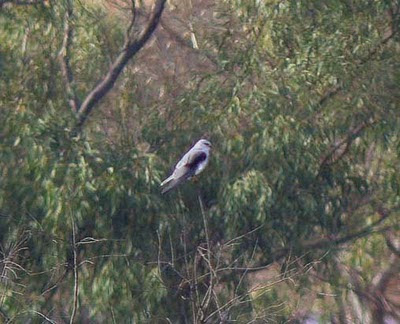
Yesterday, the weather conditions seemed to be right to check a nearby wetland- and farm-area for wintering birds of prey. It is particularly interesting for Booted Eagles (Aquila pennata) and Black-winged Kites (Elanus caeruleus). Total count was 6 Ind. pale-morph Booted Eagles (this has been the minimum count, avoiding possible double counts). I saw up to 4 of them soaring together and two birds gave very close views. Black-shouldered- or Black-winged Kites were at least 3 Ind., plus possible two more in the far distance. Other birds of prey I observed during my one hours stay, were Common Buzzard (Buteo buteo) - 3 Ind., calling and showing display flights, 2 juvenile or female Marsh Harriers (Circus aeruginosus) and an Osprey (Pandion haliaetus).
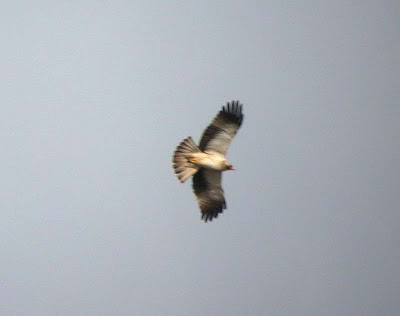
When I arrived at my observation-point, which overlooks most of the area, I was already welcomed by a continuously calling Booted Eagle, perched somewhere in the Eucalyptus in front of me. I soon found the bird with the scope, a pale morph - juvenile, with broad, pale margins to the tail feathers...still calling long rows of "gji gji gji" or "jik jik jik", it approached another Booted in the same group of trees. It then occurred to me, that this calls I hear so frequently are begging-calls of the juveniles/first winter birds, still following their parents and begging them for food (no wonder they were hungry after all that heavy rain...)also here in their wintering grounds.
I observed the same on Terns - wintering Sandwich Terns (Sterna sandvincensis) and Caspian Terns (Sterna caspia) are both followed by the juveniles when scanning the channels of Ria Formosa for food and I several times saw the young ones being fed with fishes on the water, when the adult was successful. The young ones also call a lot while following the adults... So "childhood" extends into the winter and the following year in many cases apparently.... have to check what literature says regarding this matter...
Other than the birds of prey, there where about 150 White Storks in the area, about a third of them local breeders, already around their nests. The others later circled up and disappeared in northern direction, most probably "having lunch" at a rubbish dip in Serra de Caldeirão...Before the left I cold read one ring code which I will send to see where the bird comes from.
Birds heard or seen from my watch point where Cetti's Warbler, Common Waxbill, Penduline Tit, Iberian Green Woodpecker, Sardinian Warbler, Spottless Starling, Azure-winged Magpie, Hoppoe and a few others. Also Mediterranean Tree-Frogs are calling now, that everything is green and there is water almost "everywhere".
First Swallows are arriving already. Single Barn Swallows(males usually) can be seen in their breeding areas already, I did so yesterday in two locations. Its hard to say if this Ind. have been staying here during the winter or are coming back from Africa already. There are definitely small winter flocks, especially in- or near the wetlands with reed beds, which are giving food and shelter / night-roost.
Yesterday, I observed at least 3 Crag Martins, 2 House Martins, 1 Red-rumped Swallow and 1 Barn Swallow from my vantage-point while looking for the raptors.
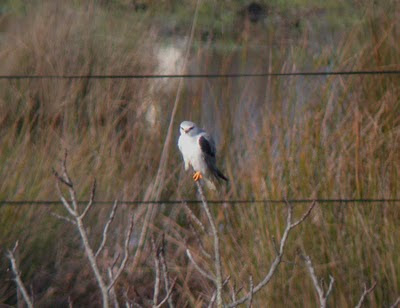
Well, this little census was my "duty" but I was curious if the cold in Central and Western Europe had pushed down some Gulls from the North Atlantic to the Algarve already, so I went to check one of my favourite spots for Gulls in the Central Algarve.
No, not yet, was the result. But a juvenile Razorbill (Alca torda) was still in the little fishing harbour of Quarteira. Majority of small Gulls in the area were Mediterranean Gulls (Larus melanocephalus)- about 150 at least I would say, which is a good number for the winter. Most Gulls were feeding at the breakwaters. Among the few Gulls roosting at the beach; I found one adult Lesser Black-backed Gull (Larus fuscus) with a colour-ring (photo). The bird had heavy problems with this ring and could not use the leg. It seems this occasional happens. Other Gulls where just of the common species. But I found a Pied Wagtail (Motacilla alba yarrellii) - a scarce winter-visitor to the Algarve, coming from the British Isles. Additionally information about the sub-species of White Wagtails you can find here.
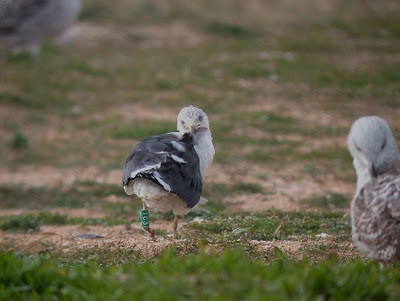
Adult Lesser Black-backed Gull. Quarteira, 11.01.2010.
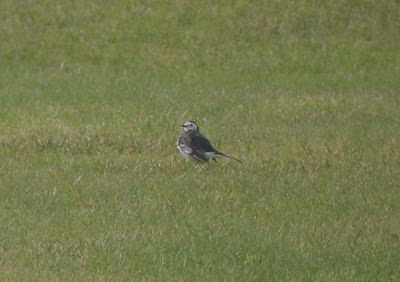
Pied Wagtail (Motacilla alba yarrellii) Quarteira, 11.01.2010.

No comments:
Post a Comment